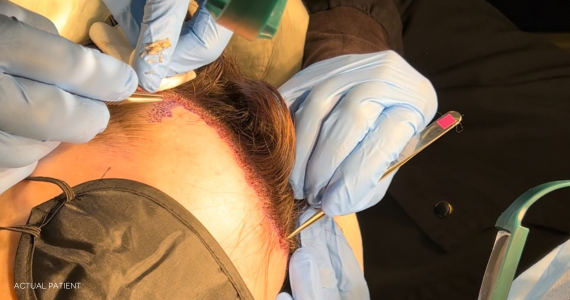When considering hair restoration surgery, a lot of focus is placed on the donor area, the portions of the scalp where healthy hair follicles are extracted to be transplanted to the areas of loss or thinning. While the donor hair is critical to a successful hair transplant, an equally important aspect is the recipient area. This is where the new hair will be transplanted, and the artistry, precision, and expertise involved in the placement of the grafts can be the difference between a natural-looking result and a noticeable, poorly executed transplant.
For our board-certified hair restoration surgeons, the recipient area is where their surgical skills and aesthetic vision truly come to life. Let’s explore why this area is so important and how it influences the overall success of a hair transplant procedure.
1. Natural Hairline Design
The first and most noticeable feature of a hair transplant is the hairline. It frames your face and plays a crucial role in your overall appearance. Designing a natural-looking hairline requires an understanding of facial proportions, age-appropriate density, and the natural direction of hair growth. A well-designed hairline isn’t just about placing grafts; it’s about giving the appearance of naturally growing hair.
Our surgeons will consider:
- The age and lifestyle of the patient: A youthful hairline might look great in your 30s, but it needs to age gracefully.
- The density and placement of grafts: Grafts must be spaced appropriately to ensure appropriate density without looking too thick or too sparse.
- The angle and direction of grafts: To ensure that the transplanted hair grows naturally, each follicle must be placed with precise attention to the natural growth pattern.
2. Achieving the Right Density
The density in the recipient area is key to creating a full, natural look. Over-packing the area with too many grafts can lead to unnatural results, while under-packing can result in a thin appearance, wasting valuable donor follicles. It’s important to know how to balance the number of grafts in the recipient area for a natural result while preserving enough donor follicles for potential future procedures.
The density should also vary depending on the location of the recipient area. For example, the front of the scalp may require more density than the crown, which typically has a natural swirl and lower density in non-balding individuals.
3. The Direction of Hair Growth
Each follicular unit has a unique direction of growth, and this needs to be replicated in the recipient area. As grafts are placed, it’s necessary to take into account the angle of implantation to match the surrounding hair’s natural flow. A slight mistake in this direction can result in an artificial look that can be difficult to correct.
For example, hair grows at a shallow angle near the hairline and a steeper angle toward the crown. Understanding this intricate detail ensures the transplanted hair blends seamlessly with existing hair, creating a smooth transition from the transplanted area to the natural hair.
4. Crown Area Considerations
The crown, or vertex, can be one of the trickiest areas to restore because of its swirling growth pattern. Our surgeons and hair restoration team take special care in the crown to replicate any natural whorl patterns a patient may have. The goal is to make the newly transplanted hair indistinguishable from the surrounding hair, maintaining the crown’s natural appearance.
Also, since the crown typically has a lower density than the hairline or middle of the scalp, grafts must be strategically placed to maximize coverage without creating an unnatural, overly dense look.
5. Long-Term Planning
Hair loss is progressive, which means that even after a successful hair transplant, further thinning may occur in other areas of the scalp. Future loss is taken into consideration when designing the recipient area, ensuring that enough donor follicles are preserved for potential follow-up procedures.
This careful planning also ensures that the transplanted hair will look natural as you age. The placement of grafts, especially along the hairline, should be done with the understanding that your face and scalp will change over time.
6. The Importance of Surgeon Expertise
The planning and execution involved in crafting a natural-looking, lasting hair restoration require years of experience, artistic vision, and a deep understanding of hair anatomy. Choosing the right hair restoration surgeon means selecting someone who not only understands the mechanics of hair transplantation but also has the artistic ability to create a result that enhances your natural appearance.
By approaching the areas of thinning and/or loss with meticulous care, ensuring that the hairline is natural, the density is appropriate, and the hair grows in the correct direction, the recipient area becomes the foundation for a beautiful, natural-looking head of hair that can restore confidence.
If you are interested in the options available to you for hair restoration, contact our office to learn more and schedule a personal consultation appointment.

Leave a Reply